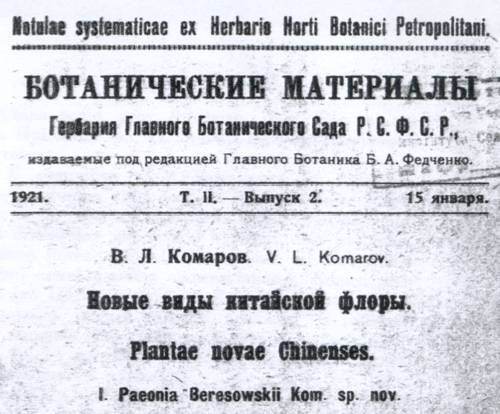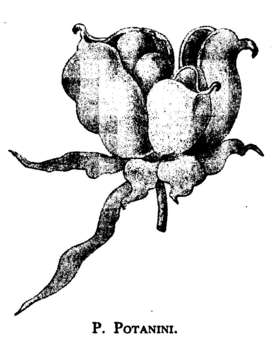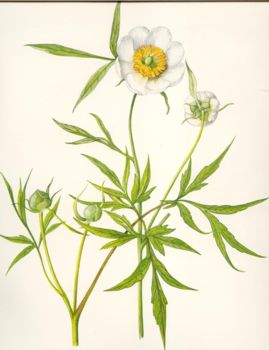accepted name (2005):
P. delavayi (Hong 1996)
1921
original description:

![]()
Paeonia Potanini Kom. sp. nov .
(Sect. Moutan) Suffruticosa. ramosa, ramis lignosis, 0.5—1.5 metr. alta, glaberrima, rami foliiferi apicales herbacei usque ad 0.5 cm. crassi basi squamis coriaceis cincti, teretes. Folia biternatim secta membranacea, subtus glauca, longiter petiolata usque 25 cm. longa, 30 cm. lata, segmentis pinnatifidis, lobis lanceolatis vel angaste-lanceolatis aciminatis, margine reflexo, subintegra. Flores plerumque plures, terminales et axillares eupuliformis 5-6 cm. in diametre, pedicello 4—15 cm. Ig.; bractei lineari-lanceolati integri vel pinnatisecti calyce adnati, sepala latiora quam lata, exteriora 2 herbaceo-acuminata, interiora 3 ampliora rotundata, corolla saturate rosea vel atropurpurea, suaveolens, discus cupularis, 3—4 ml. Ig. margine irregulariter fisso, filamenta numerosissima plana antheris luteis obliquis 4 — 5 ml. Ig.; carpella glabra 2—4 conica fusca, stigmate obliquo brevi.
Legit G.. N. Potanini comes Kashkarov 19. V: 1893, in prov. Szechuan, distr. Da-dsjan-lu (Ta-chien-lu) in valle fl. Jalung inter pagos Nahtschuka et Mahejdzun, solo argilloso. Ut videtur, cum P. Delavayi v. angustiloba Rehder et Wilson nov. var. (in Sargent Plantae Wilsonianae, III, 318) a clar. Wilson lecta, identica. Crescit ille occidentem versus a Da-dsjan-lu in valle fl. Yalung locis lapidosis soli perfecte exponatis, 3000 - 3600 m. supra mare.
Paeonia Delavayi nunc pro conspecie habetur, in species 3 elementariis discedente:
1. P. Delavayi Franchet. (Plantae Delavayanae, 1889, 31) f. segmentis lanceolatis v. ovato-lanceolatis, lobis ad 2 cm lt., petala antheraque atropurpurea, carpella 5 glabra. Leg. Delavay, Yun-nan, in dumetis ad juga nivala Li-kiang, 3500 m , 9. VII. 1884.
2. P. lutea Delavay (in Franchet Bull. Soc. Bot. XXXIII. 372, 1886) segmentis obovato-oblongis, lobis lanceolatis v. late ovatis obtusis, petala lutea, carpella 2-4 , glabra. Leg. Delavay, Yun-nan, locis multis
3. P. Potannini nova, segmentia pianatifidis, lobis anguste lanceolatis acuminatis, petala purpurea vel rosea. carpella 2—4 glabra.
Stebbins (1939)
P. Delavayi var. angustiloba Rehder and Wilson, PIantae Wilsonianae, 1, 318,1913.
This is a weak variety, and its elevation to a species, P. Potanini, by Komarov (Not. Syst. Herb. Hort. Bot. Petr. II. 7.1921) is wholly unjustified.
P. Delavayi is undoubtedly the oldest, most primitive species of the genus. It shows relationships with members of both of the other subgenera, resembling the American species of the subgenus Onaepia in the character of its seeds, and approaching them in the size and scalloping of its disk and the size and color of the petals, while it approaches P. Emodi and P. anomala of the subgenus Paeon in the character of its leaves and sepals, and resembles them in the shape of its follicles and stigmas.
Stern (1946):
5. Paeonia Potanini Komarov in Not. Syst. Herb. Hort. Bot. PetroP.2, 7 (1921) ; Schipczinsky, ibid. 47 (1921); F. C. Stern in Jown. Roy. Hort. Soc. 68, 1125 (1943).
Syn. P.Delavayi var. angustiloba Rehder & Wilson in Sargent, Plant. Wilson. 1, 318 (1913); Bailey, Stand. Cycl. Hort. 5, 2434 (1916) ; Rehder, Man. Cult. Trees and Shrubs, 215 (1927) ; Bean, Trees and Shrubs, 3, 265 (1933).
Description. A shrub up to about 1-5 m. high {fide Komarov), but 63-83 cm. high in cultivation in this country, stoloniferous and quite glabrous. Leaves biternate, but the leaflets so deeply and spreadingly dissected that they are difficult to classify, and the leaf may conveniently be described as ternate ; petiolule of middle primary division mostly 5-7 cm. (in cultivation up to 9 cm.) long, petiolule of lateral primary divisions i-a cm. (in cultivation up to 4-5 cm.) long ; petioles 11-12 cm. (in cultivation up to 15 cm.) long ; primary divisions 5-7,. pinnatipartite, the segments widely separated from one another and themselves pinnatipartite or lobed (the lower) or deeply pinnately-lobed to entire (the upper), segments and lobes oblong, tapering to the acuminate apex, mostly 5-10 mm. wide, up to 1.5-2 cm. wide only in the lower part of the less dissected upper segments. Flowers 5-6 cm. across. Bracts and sepals (forming a single series) 5-7 ; the outer 2 or 3 (rarely 4) oblong, acuminate, 2.5-5 cm. (in cultivation up to 7 cm.) long by 5.5-6 mm. wide, foliaceous; the remainder hemispherical to suborbicular and caudate or sharply cuspidate to rounded, 1-1.7 cm. in diameter, the innermost 2 or 3 somewhat pale green, often flushed with red, strongly concave. Petals deep maroon-red, obovate to broadly-obovate springing from a cuneate base, apex rounded or notched, margin slightly irregular, 2.5-3 by 1.5-2.2 cm. Stamens 1.3 to 1.5 cm. long, filaments red, anthers yellow. Carpels 2-3, glabrous, 1.2-1.3 cm. long, conical-flask-shaped, attenuated to the circinnate stigma. Disc produced as conspicuous fleshy lobes, up to 2-5 mm. high, round the base of the carpels. Follicles sometimes 1-5 but mostly 2-3 cm. long and very wide.

Distribution. china : western Szechwan, Tachien-lu district in Yalung valley, Potanin (fide Komarov) ; west of Tachien-lu descent to Yalung river, 3000-3600 m., Wilson Am, Arb. Exped. 1333 (K), same locality, Wilson Veitch ExP.3033 (K) ; Yunnan, hills around Yungning, 9500-10,000 ft., Forrest 12503 (E).
Paeonia Potanini differs from P.Delavayi in the absence of the conspicuous involucre typical of P.Delavayi and also in the narrower segments of the leaves, smaller flowers, paler colour of the stamens and in the manner of growth. It differs from P.lutea in having much narrower leaf segments, in its more erect growth and in the smaller flowers. The habit of growth of P.Potanini is stoloniferous and it spreads very fast in the garden. Komarov reports it as growing up to 1-5 m. high, which is much taller than any specimens I have seen. The report may be a mistake as it is not much more than half this height in cultivation.
Rehder and Wilson{I.e.} originally considered it to be a variety of P.Delavayi and named it P.Delavayi var. angustiloba, but Stapf regarded it as a species and named it P.angustiloba in MS. in the Kew Herbarium. I am in agreement with Stapf and consider it should retain its specific rank as it differs fundamentally from P.Delavayi in the absence of the conspicuous involucre. This being the case the name must be P.Potanini, the name given to it by Komarov.
Wilson collected this species in western Szechwan in 1904. It appears to have a restricted range spreading from the hills around Yungning in the south-west comer of Szechwan, on the border of Yunnan at about 10,000 ft., northwards near the Yalung river west of Tatsienlu in western Szechwan. [end page 048] Several forms are to be found in herbaria and also in the garden which vary in the size of the leaf-segments, some being very narrow indeed and some up to 2 cm. wide in the broadest part; variations also are shown in the flower colour, which range from maroon-red to bronze.
P.Potanini will grow in the garden in sun or shade and is not particular as to soil. It increases very fast by stolons and is suitable as an undershrub in the woodland garden, where it is handsome both in leaf and flower. It flowers in England at the end of May.
There is a white form of this species in cultivation which is described below.
P.Potanini forma alba F. C. Stern, forma nov. Syn. P.Delavayi var. alba Bean, Trees and Shrubs, 3, 265 (1933).
 P.Potanini
forma alba differs from the type in having white flowers,
in the filaments being green instead of pink and the stigma white
instead of reddish. In a letter dated May 12, 1923, Forrest
writes, "Probably the white-flowered plant is only a form,
for I remember being told of a white paeony having been seen on
the T'ong Shan, which lies east of the Lichiang range in lat. 27°
35', though I never managed to get specimens of it."
P.Potanini
forma alba differs from the type in having white flowers,
in the filaments being green instead of pink and the stigma white
instead of reddish. In a letter dated May 12, 1923, Forrest
writes, "Probably the white-flowered plant is only a form,
for I remember being told of a white paeony having been seen on
the T'ong Shan, which lies east of the Lichiang range in lat. 27°
35', though I never managed to get specimens of it."
The flowers of this form selfed with its own pollen have never set seed in my garden, but unprotected flowers have done so ; these gave rise to taller growing plants with small pink flowers, which looked like hybrids with P.Delavayi. They appeared to be intermediate between the two species in height, in the colour of the flowers and in the size of the leaves ; P.Delavayi was growing about 10 yards away. [end page 049]
Fang (1959):
Paeonia Potanini Komarov in Not. Syst. Herb. Hort. Bot. Petrop., 11. 7 (1921).— Schipczinsky in Not. Syst. Herb. Hort. Bot; Petrop., II. 47 (1921).—F. C. Stern in Journ. Roy. Hort. Soc., LXVIII. 125 (1943); Stud. Gen. Paeonia, 48 (1946).
Paeonia Delavayi Franchet var. angustiloba Rchder et Wilson in Sargent, PI. Wilson., I. 318 . (1913)—Bailey, Stand. Cycl. Hort., V. 2434 (1916).—Rehder, Man. Cult. Trees & Shrubs, 1st Ed., 215 (1927), 2nd Ed., 5th Print., 205(1951).—Trees & Shrubs, III. 265 (1933), Chen, Ill. Man. Chin. Trees & Shrubs, 1st Ed.. 262 (1937), 2nd Ed., 262 (1957).—Bean.
Paeonia angustiloba (Rehder et Wilson) Stapf, mss. in Kew Herb. ex F. C. Stern, Stud. Gen. Paeonia, 48 (1946), mentioned as a syn.
S. W. Szechuan: Muli (T. T. Yu. 14147).
N. W. Yunnan: Likiang Hsien (C. W. Wang, 70489: T. T. Yu, 5163 & 8107).
Dr. F. C. Stern, after seeing the type of P. Potanini, considers it being identical with P. Delavayi var. angustiloba and took up Komarov's specific epithet as the valid name. I am following him in keeping this identification.
This species is near P. Delavayi but differs in the narrower lobes of the leaf and the comparatively smaller flowers with shorter and narrower bracts. The distribution of the species ranges from the type-locality in western Kang-ting Hsien southward to northeastern Yunnan. It is found in thickets at 2400 to 3000 metres in altitude but nowhere common.
Paeonia delavayi Franch., Bull. Soc. Bot. France 33: 382. 1886. TYPE: China. NW Yunnan: Lijiang (Likiang), Delavay 1142 (holotype, P; isotype, K).
......
Paeonia potaninii Kom., Bot. Mater. Gerb. Glavn. Bot. Sada RSFSR 2: 7. 1921. TYPE: China. W Sichuan: Yajiang (Tachien-lu district in Yalung valley), Potanin s.n. (holotype, LE)......
Paeonia potaninii was described as new because it was considered to have narrower leaf segments than P. delavayi and P. lutea. However, we observed that the width of leaf segments varies greatly, and ranges from 0.4 to 2.86 cm within the complex, and from 0.76 to 1.83 cm in population H95070, the type locality of P. potaninii, which falls in the middle of the overall variation range in the complex (Fig. 4). The same situation was found for the length of leaf segments. Therefore, it is evident that P. potaninii is rather similar to P. delavayi and P. lutea in this regard.
1998
reference of
Wang (1998):
Paeonia potaninii Kom. in Not. Syst. Herb. Hort. Bot. Petrop., DL 7, 1921. - P. delavayi Franch. var. angustiloba Rehd. and Wils.
Shrub 1 - 1.5m in height. Stems glabrous, light green or greyish-green. Leaves opposite or nearly opposite, bitemate pinnate. Leaflets glabrous with 3-5 deep and narrow lanceolate clefts, upper surface green, underneath light green. The base of the terminal and lateral leaflets extend downwards with wing-shaped petioles. Flower red or reddish-purple (Fig. 6).
This species apparently is closely related to P. delavayi and P. lutea. Distributed among bushes on mountain slopes at 2800-3700m in western Sichuan, also at 2300-2800m in Yunnan. In Yajiang County P. Potaninii is generally distributed in fertile black earth in river valleys and forest fringes with accompanying plants Malus spectabilis, Broussonetia papyri/era, Cotoneaster cylindricum, Sorbaria sorbifolia, Lespedeza sp. and Rosa hugonis.
1999
HONG De-Yuan & PAN Kai-Yu Taxonomical history and revision of Paeonia sect. Moutan (Paeoniaceae) Acta Phytotaxonomica Sinica 37(4):351-368(1999)